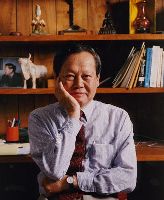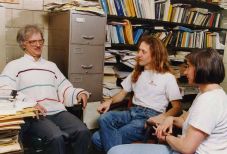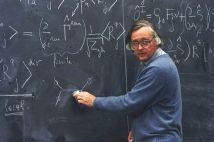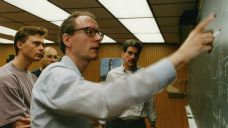Research at the C.N.Yang Institute for Theoretical Physics includes varied topics of fundamental interest. Quantum-field theories supply the language for our description of matter on the smallest scales. Supersymmetric field theories and supergravity and string theories are being studied and developed, with attention to both their mathematical structure and physical consequences. Of special interest is the quantum mechanical description of gravitation and its relation to other forces. In addition, there is an active program in statistical mechanics, particularly in the area of exactly solvable models. Progress in statistical mechanics and field theory is facilitated by the many physical concepts and mathematical methods that they share. Other active areas of study address the forces and particles of high-energy physics referred to as the "standard model," including electroweak interactions and quantum chromodynamics. Recent and ongoing studies include detailed phenomenological calculations and analysis of high-energy scattering experiments, the development of improved approximation methods for both quantum chromodynamics and electroweak interactions, the analysis of neutrino masses and other extensions of the standard model, computer-based lattice simulations of fermionic systems, and the study of magnetic monopoles and high-energy particle-nucleus collisions. This wide range of topics and interests encourages fruitful interactions with the nuclear physics, condensed matter, high-energy experimental, nuclear experimental, and other groups in the Physics Department, as well as with the departments of Mathematics and Applied Mathematics.
 |
The main but not exclusive areas of research in the YITP are quantum field theory and statistical mechanics. In both subjects, one considers systems with an infinite number of degrees of freedom, the values of a field such as the electro-magnetic field at each point in space in the former case and the positions of each atom in an ensemble or the values of a variable such as the spin of a particle at each point of a lattice in the latter. These similarities have in recent years led to a converging of the methods and techniques used in calculations in the two fields. In particular, a class of two-dimensional models called Conformal Field Theories play an important role both in statistical mechanics and in string theory. Thus, many members of the YITP as well as their students and research associates have been working in both areas.
 |
In statistical mechanics there is a strong effort in studying the properties of exactly soluble models. These systems are often called "integrable" because they have as many independent constants of the motion as there are degrees of freedom. Despite the special nature of these systems, they show interesting behavior such as phase transitions to states with such properties as permanent magnetization and superconductivity. Of particular interest are correlation functions which describe the behavior of widely separated particles in the system in ordered and disordered phases. There are cases in which these simplified models capture the behavior of real physical systems, and through their study we can gain important insights into behavior of matter in condensed or solid states.
Off-diagonal long range order (ODLRO) has long been held to be the fundamental property underlying both superconductivity and super-fluidity. It has recently been proven, that in the case of a uniform magnetic field, ODLRO directly implies the two basic properties of superconductivity, Meissner effect and magnetic flux quantization. Work continues to extend the proof to the case of non-uniform magnetic fields and to seek a proof of super-fluidity as a direct consequence of ODLRO.
Recently, a new form of carbon molecules has been discovered. Because of their structural similarity to geodesic solids, they have been called "fullerenes." The energy levels of these molecules can be understood on the basis of a simplified picture called the Huckel model. Calculations are under way to apply the model to tubes and large molecules of fullerenes.
Following the experimental verification in Colorado and MIT of Bose-Einstein Condensation of atoms in a trap, theoretical analysis of the phenomenon has been carried out at the YITP. It was found that for repulsive cases the condensate extends to a region of the trap where the trap potential is less than a fixed value determined by the total number of trapped atoms. Work is continuing on light scattering by the condensate and on the possibility of an Andronikashvilli experiment.
 |
Efforts in elementary particle physics and quantum field theory range from calculation of the predictions of the "Standard Model" for experiments planned or under way at the highest energy accelerators to attempts to extend the model and find a unified description of the fundamental forces of nature including gravity.
The production of heavy quarks (charm, bottom and top) in antiproton-proton, photon-proton and electron-proton collisions are calculated by resumming the perturbation series for Quantum Chromodynamics (QCD). These massive objects are created in the collisions of light quarks in the reactions mentioned. The theoretical predictions for differential and total cross sections can be compared with present experimental data from CERN, Fermilab and DESY and also used to predict production rates for future experimental facilities.
Other studies deal with QCD calculations of jet production at very high energies in colliding-beam facilities and with tests of the structure of nucleons and the propagation of quarks and gluons in nuclear matter which can be tested in fixed target experiments at intermediate energies. Research continues of the idea of limiting fragmentation with tests proposed in proton-virtual photon collisions at the PETRA accelerator in Germany.
Theoretical ideas supported by some indirect evidence from experiments suggest that the underlying theory of fundamental particles is supersymmetric, with bosons and fermions ocurring in pairs. Since the SUSY partners of the known particles have not been found, the symmetry is broken and the partners, if they exist, are more massive but hopefully light enough to be discovered in the next generation of collider accelerators. The phenomenological consequences of these models are investigated. Other calculations try to understand the pattern of observed fermion masses and the mixing of quarks observed in the weak interactions in the context of the minimal supersymmetric extension of the standard model.
Lattice field theory in which continuous space-time is replaced by a discrete lattice of points is a powerful method for studying the properties of quantum field theory, especially those of a nonperturbative nature. Both analytic calculations and numerical simulations have been used to obtain evidence that as one eliminates the short distance cut off of Yukawa theory and quartic scalar coupling theory, the renormalized charges, which determine the strength of the interactions, vanish. Therefore, these should be interpreted as effective field theories with a finite high-energy or short distance cut off. These results also place upper bounds on the fermion masses generated by the Higgs mechanism in the standard model.
String theory is an attempt to find a more unifying description of matter than the particle in terms of a geometrically more complicated object. In string models the fundamental constituents of nucleons (quarks and gluons) as well as the weakly interaction fundamental particles (leptons, photons, weak vector bosons, gravitons) can be described in terms of the vibrational modes of a single kind of string. The unified description of the origin of all these kinds of fundamental particles also has the benefit of eliminating infinities which occur in ordinary field theories. For the quantization of gravity, this is essential. For other interactions, it justifies the renormalization prescriptions which have been developed to give accurate descriptions of low energy phenomena.
Recent research in string theory includes the study of its quantization, the implications of its supersymmetry, its new symmetries and the new insight it gives into particle physics. There remain many aspects of string theory which are still ill-understood, in particular, what is the stringy analog of geometry in classical general relativity? "T-Duality," a symmetry transformation that relates classically distinct geometries, is studied in hope of clarifying this problem. It has also led to the realization that strings contain solitonic objects called branes. Dualities generalizing electromagnetic duality relate strongly and weakly coupled string theories and have given insight into nonperturbative aspects of strings and branes.
At low orders of perturbation theory, it has been shown that the low energy limit of superstring theory gives scattering amplitudes identical to those obtained from field theories of particles except that the string amplitudes contain an explicit fundamental length which cuts off the divergent behavior of field theory at small distances. It is still being investigated how this occurs in general - how a Lagrangian "effective field theory" with a built in cut off emerges as the low energy limit of string theory.
Since its discovery at Stony Brook in 1976, supergravity, the supersymmetric extension of general relativity, has been a topic of active research. Since any string theory reduces to a supergravity theory at energies accessible to experiments, study of supergravity models is necessary if strings are to make contact with experiments. These investigations, using superspace as well as ordinary space methods, continue to reveal new aspects of quantum gauge theory in general. In addition, supergravity plays a key role in new developments in mathematics (twistors, Donaldson invariants, etc.).
Finally, supersymmetric theories are often more tractable that their bosonic counterparts. In particular, the results of Seiberg and Witten have opened new theoretical areas for exploration. Quantum corrections to monopoles as well as the effective actions of these theories are currently being investigated.







